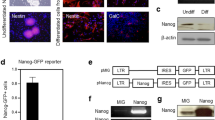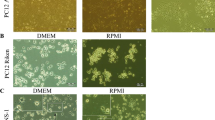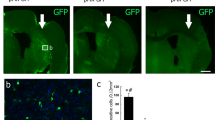Abstract
Expression of anti-apoptotic or neurotrophic transgene proteins in hypoxic neurons may provide a novel therapeutic strategy for neuroprotection and alleviation of damage to ischemic brain areas. NT2, a human neoplastic cell line which terminally differentiates into postmitotic neurons (NT2N) by treatment with retinoic acid was used in this study as a cell culture model for human neuronal cells. The hypoxia-inducible VEGF promoter in plasmid vectors was employed to drive the expression of marker genes (luciferase) and therapeutic genes (bcl2) in hypoxic NT2 cells and NT2N neurons in culture. Cationic liposomes complexed with plasmid DNA were used for transfection of vectors with the constitutive cytomegalovirus promoter (pCMV) or the hypoxia-inducible VEGF promoter (pHRE). Hypoxic or normoxic control NT2 cells transfected with pCMV-luciferase showed high transgene expression (2.4 × 108 relative light units (RLU)/mg protein). Control NT2 cells transfected with pHRE-luciferase had a rather low activity (4.9 × 106 RLU/mg protein), which was induced 34-fold under hypoxic conditions. Four-fold induction of luciferase expression was obtained in hypoxic NT2N neurons transfected with pHRE compared with normoxic controls. The hypoxia-induced luciferase expression in NT2N cells was 34% of the activity of pCMV-luciferase under the same conditions. Transfection of NT2N neurons with pCMV-bcl2 or pHRE-bcl2 was demonstrated to reduce significantly the numbers of apoptotic cells after hypoxia. These results demonstrate efficient VEGF promoter-mediated induction of transgene expression in hypoxic human neurons. This cell culture model may be employed for the further investigation of therapeutic proteins against ischemic brain damage due to neuronal loss.
This is a preview of subscription content, access via your institution
Access options
Subscribe to this journal
Receive 12 print issues and online access
$259.00 per year
only $21.58 per issue
Buy this article
- Purchase on Springer Link
- Instant access to full article PDF
Prices may be subject to local taxes which are calculated during checkout




Similar content being viewed by others
References
Lipton P . Ischemic cell death in brain neurons Physiol Rev 1999 79: 1431–1568
Mattson MP, Culmsee C, Yu ZF . Apoptotic and antiapoptotic mechanisms in stroke Cell Tissue Res 2000 301: 173–187
Brown JM . Exploiting the hypoxic cancer cell: mechanisms and therapeutic strategies Mol Med Today 2000 6: 157–162
Dachs GU et al. Targeting gene exprssion to hypoxic tumor cells Nat Med 1997 3: 515–520
Prentice H et al. Regulated expression of a foreign gene targeted to the ischaemic myocardium Cardiovasc Res 1997 35: 567–574
Shibata T et al. Enhancement of gene expression under hypoxic conditions using fragments of the human vascular endothelial growth factor and the erythropoietin genes Int J Rad Oncol Biol Phys 1998 42: 913–916
Binley K et al. An adenoviral vector regulated by hypoxia for the treatment of ischaemic disease and cancer Gene Therapy 1999 6: 1721–1727
Boast K et al. Characterization of physiologically regulated vectors for the treatment of ischaemic disease Hum Gene Ther 1999 10: 2197–2208
Koshikawa N, Takenaga K, Tagawa M, Sakiyama S . Therapeutic efficacy of the suicide gene driven by the promoter of vascular endothelial growth factor gene against hypoxic tumor cell Cancer Res 2000 60: 2936–2941
Shibata T, Giaccia AJ, Brown JM . Development of a hypoxia-responsive vector for tumor specific gene therapy Gene Therapy 2000 7: 493–498
Pleasure SJ, Page C, Lee VM . Pure, postmitotic, polarized human neurons derived from Ntera 2 cells provide a system for expressing exogenous proteins in termially differentiated neurons J Neurosci 1992 12: 1802–1815
Cheung WM, Fu WY, Hui WS, Ip NY . Production of human CNS neurons from embryonal carcinoma cells using a cell aggregation method BioTechniques 1999 26: 946–954
Almaas R, Saugstad OD, Pleasure D, Pootwelt T . Effect of barbiturates on hydroxyl radicals, lipid peroxidation, and hypoxic cell death in human NT2-N neurons Anesthesiol 2000 92: 764–774
Mortimer I et al. Cationic lipid-mediated transfection of cells in culture requires mitotic activity Gene Therapy 1999 6: 403–411
Simoes S et al. Human serum albumin enhances DNA transfection by lipoplexes and confers resistance to inhibition by serum Biochim Biophys Acta 2000 1463: 459–469
Semenza G . Perspectives on oxygen sensing Cell 1999 98: 281–284
Zhu H, Bunn H . Oxygen sensing and signaling: impact on the regulation of physiologically important genes Resp Physiol 1999 115: 239–247
Ruan H et al. Hypoxia-inducible expression of BAX: application in tumor-targeted gene therapy Neurosurg Focus 2000 8: 1–7
Shimazaki K et al. Adeno-associated virus vector-mediated bcl-2 gene transfer into post-ischemic gerbil brain in vivo: prospects for gene therapy of ischemia-induced neuronal death Gene Therapy 2000 7: 1244–1249
Lawrence MS et al. Herpes simplex viral vectors expressing Bcl-2 are neuroprotective when delivered after a stroke J Cereb Blood Flow Metab 1997 17: 740–744
Deininger MH, Weller M, Streffer J, Meyermann R . Antiapoptotic Bcl-2 family protein expression increases with progression of oligodendroglioma Cancer 1999 86: 1832–1839
Nor JE et al. Up-regulation of Bcl-2 in microvascular endothelial cells enhances intratumoral angiogenesis and accelerates tumor growth Cancer Res 2001 61: 2183–2188
Thorsell A, Fox E, Heilig M . Lipid mediated gene delivery in the adult rat brain: quantitative analysis of expression Neurochem Int 1999 35: 65–71
Grubb BR et al. Inefficient gene transfer by adenovirus vector to cystic fibrosis airway of mice and humans Nature 1994 371: 802–806
Meyer KB et al. Intratracheal gene delivery to the mouse airway: characterisation of plasmid DNA expression and pharmacokinetics Gene Therapy 1995 2: 450–460
Ciccarone V, Hawley-Nelson P, Jessee J . Cationic liposome-mediated transfection: effect of serum on expression and efficiency Focus 1993 15: 80–83
Trivedi RA, Dickson G . Liposome-mediated gene transfer into normal and dystrophin-deficient mouse myoblasts J Neurochem 1995 64: 2230–2238
Vitiello L et al. Condensation of plasmid DNA with polylysine improves liposome-mediated gene transfer into established and primary muscle cells Gene Therapy 1996 3: 396–404
Zelphati O, Uyechi LS, Barron LG, Szoka Jr FC . Effect of serum components on the physico-chemical properties of cationic lipid/oligonucleotide complexes and on their interactions with cells Biochem Biophys Acta 1998 1390: 119–133
Pires P et al. Interaction of cationic liposomes and their DNA complexes with monocytic leukemia cells Biochim Biophys Acta 1999 1418: 71–84
Acknowledgements
This study was supported by a grant from the E-Kröner-Fresenius Foundation (NGR), and in parts by grants: Ra 705/4-1 from the German Research Council (DFG), 2794A/0087H and 3067A/0029G from the Federal State of Saxony-Anhalt, and a grant from the Bartling Foundation Hannover (all to NGR).
Author information
Authors and Affiliations
Rights and permissions
About this article
Cite this article
Cao, YJ., Shibata, T. & Rainov, N. Hypoxia-inducible transgene expression in differentiated human NT2N neurons – a cell culture model for gene therapy of postischemic neuronal loss. Gene Ther 8, 1357–1362 (2001). https://doi.org/10.1038/sj.gt.3301536
Received:
Accepted:
Published:
Issue Date:
DOI: https://doi.org/10.1038/sj.gt.3301536
Keywords
This article is cited by
-
PPARα Activation Attenuates Amyloid-β-Dependent Neurodegeneration by Modulating Endo G and AIF Translocation
Neurotoxicity Research (2015)
-
CoCl2 induces apoptosis through the mitochondria- and death receptor-mediated pathway in the mouse embryonic stem cells
Molecular and Cellular Biochemistry (2013)
-
Brain tumor hypoxia: tumorigenesis, angiogenesis, imaging, pseudoprogression, and as a therapeutic target
Journal of Neuro-Oncology (2009)
-
In vitro angiogenesis by human umbilical vein endothelial cells (HUVEC) induced by three-dimensional co-culture with glioblastoma cells
Journal of Neuro-Oncology (2009)
-
A novel adenoviral vector which mediates hypoxia-inducible gene expression selectively in neurons
Gene Therapy (2005)



